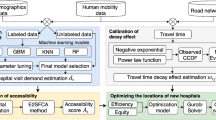Summary
This paper delves into a more explicit analysis of demand in space than has been undertaken heretofore. Utility theory is used to develop the concepts of spatial income-distribution effect, spatial-induced income effect, and spatial substitution effect, the effects on demand of changes or differences in location. Indifference curve analysis is employed to give a graphical interpretation to these concepts.
The use of this general approach to demand in space makes it apparent that the usual assumption of uniform partial demand curves is logically inconsistent in a spatial context. An assumption of spatial homogeneity of general demand functions and of income distribution is found to imply (1) generally nonidentical partial demand curves at different points in space, and thus that the existence of the demand cone requires special conditions, (2) cases where purchases may rise with increasing distance from the mill, (3) the lack of independence among the ranges of different goods, and (4) nonuniformity in the size of ranges for a given good (a) sold at different centers and (b) sold in different directions from one center.
Further work on this topic is indicated along the lines of loosening the many restrictions imposed during the analysis. Two-dimensional rather than the linear markets, discriminatory f.o.b. or equalized delivered pricing rather than nondiscriminatory f.o.b. pricing, and a transportation system with limited rather than ubiquitous access are some cases in point.
Similar content being viewed by others
References
A. Weber,Theory of the Location of Industries, trans. C. J. Friedrich (Chicago: University of Chicago Press, 1929).
J. H. Thünen,The Isolated State, trans. C. M. Wartenberg (New York: Pergamon Press, 1966).
W. Christaller,Central Places in Southern Germany, trans. C. W. Baskin (Englewood Cliffs, N. J.: Prentice-Hall, 1966), p. 22.
A. Lösch,The Economics of Location, trans. W. H. Woglom (New York: John Wiley & Sons, 1967), p. 105.
M. Greenhut,Plant Location in Theory and Practice (Chapel Hill, N.C.: University of North Carolina Press, 1956), p. 62. W. Isard,Location and Space-economy (Cambridge: The M.I.T. Press, 1956), p. 145. E. S. Mills and M. R. Lav, “A Model of Market Areas with Free Entry,”Journal of Political Economy, LXXII (1964), pp. 278–288. B. H. Stevens and C. P. Rydell, “Spatial Demand Theory and Monopoly Price Policy”,Regional Science Àssociation Papers (1966), XVII, pp. 195–204.
Lösch,op. cit., p. 108, note 6, and p. 140, note 10.
R. G. D. Allen,Mathematical Economics (London: The Macmillan Company, 1965), pp. 658–664.
Ibid., p. 658.
Ibid., p. 651.
ibid., p. 662.
Excluding inferior goods is actually more than is necessary. Only those inferior goods need be excluded that have individual income effects large enough to swamp all the other cross income effects.
J. R. Hicks,A Revision of Demand Theory (Oxford: Clarendon Press, 1959), pp. 192–193.
Ibid., p. 193.
Lösch,——op. cit., pp. 105–107.
This particular form comes from Samuelson, P. A.,Foundations of Economic Analysis (New York: Atheneum, 1965), p. 106, and is chosen here rather than the form which states prices relative to a price index. Since a price index will be a function of distance from the center, but in this paper income is not, the partial derivatives are less cumbersome using the form in equation (23).
Mills and Lav,op. cit. “, p. 278.
Samuelson,——op. cit., p. 105.
Christaller,——op. cit., p. 50.
Lösch hints at the idea, p. 124, but never makes it explicit.
T. G. Fox has pointed out to the author that the transport system implied here is basically different from that in (20). In (20) only as much transportation is purchased as desired, but here capacity exists which must be purchased whether utilized or not.
With some changes the essential argument also applies to a Löschian network.
For example, Mills and Lav,op. cit. “.
Author information
Authors and Affiliations
Additional information
The author is indebted to his discussant C. Riordan for a thorough review of the paper. Any shortcomings are the author's.
Rights and permissions
About this article
Cite this article
Long, W.H. Demand in space: Some neglected aspects. Papers of the Regional Science Association 27, 45–60 (1971). https://doi.org/10.1007/BF01954599
Issue Date:
DOI: https://doi.org/10.1007/BF01954599




